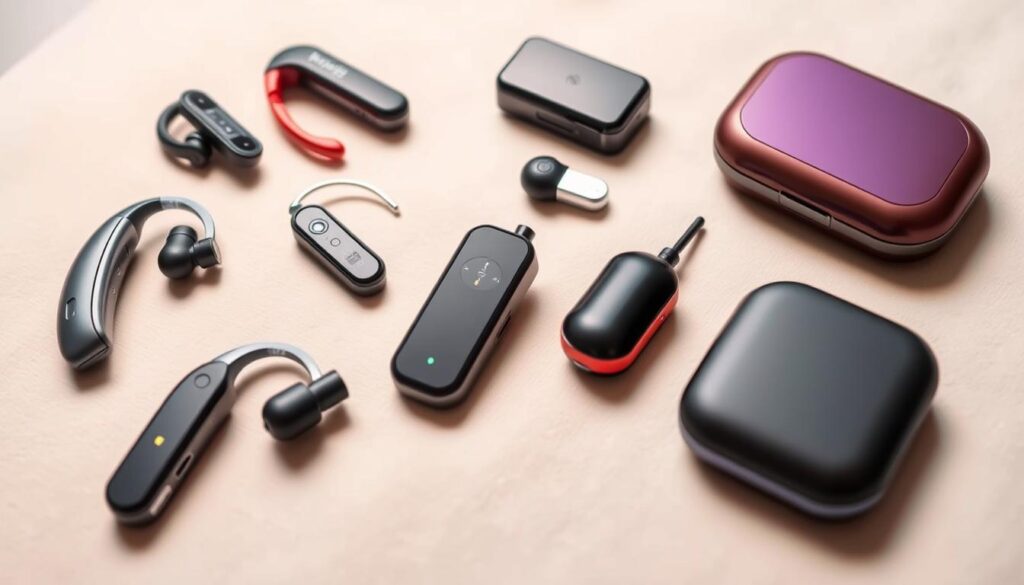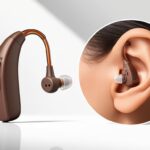Do You or a Loved One Struggle with Hearing? Discover Communication Devices for Hearing Impaired Individuals.But, thanks to new tech, there are many devices to help.
We’ll dive into the best communication tools out there. These assistive technologies aim to make life easier for those with hearing loss. They help bridge the gap in communication.
If you’re also dealing with tinnitus, a solution that promises no more whooshing, buzzing, or clicking while improving brain function and 20/20 hearing might be just what you need. Learn more about this life-changing product here.
Key Takeaways
- Assistive devices can be high-tech or low-tech, ranging from amplified phones to sign language translation apps.
- Captioned phone services, video relay services, and speech-to-text apps are essential for overcoming communication challenges.
- Cochlear implants and Bluetooth-enabled hearing aids offer advanced solutions for individuals with severe hearing loss.
- Alerting devices, such as vibrating notifications and flashing lights, can help the hearing impaired stay connected to their environment.
- Assistive listening devices, including FM systems and hearing loops, enhance communication in large facilities like classrooms and theaters.
What are Assistive Communication Devices?
Assistive devices help people with hearing loss, voice, speech, or language disorders. They make communication easier. These tools can make sounds louder, change speech to text, or show visual cues. The main types are assistive listening devices, augmentative and alternative communication devices, and alerting devices.
If you’re seeking more comprehensive hearing support, including relief from tinnitus, there’s an advanced solution designed to improve your hearing and brain function. Check it out here.
Types of Assistive Devices
Assistive Listening Devices (ALDs): ALDs make sounds clearer by reducing background noise. They work with or without hearing aids or implants.
Augmentative and Alternative Communication (AAC) Devices
Augmentative and Alternative Communication (AAC) Devices: AAC devices help people with communication disorders. They range from simple picture boards to advanced speech-generating devices.
Alerting Devices
Alerting Devices: Alerting devices use visual or tactile signals for important sounds. They are great for those with hearing loss.
These devices help people with hearing loss or communication disorders. They make it easier to join in conversations and activities.For more on overcoming hearing loss, explore this resource on improving hearing here.
Assistive Listening Devices for Large Facilities
Assistive listening devices (ALDs) help people with hearing loss in big places like classrooms and theaters. They make sound clearer and easier to hear. There are different types, like hearing loops, FM systems, and infrared systems, each good for different places.
Hearing Loop Systems
Hearing loop systems send sound directly to hearing aids or cochlear implants. This cuts out background noise. They work well in big places because they let users adjust the sound to their liking.
It’s important to keep these systems in good shape. They need to be installed right to work without interference.
Frequency-Modulated (FM) Systems
FM systems send sound through radio signals to a receiver. They’re great for places where sound needs to travel far, like classrooms. They give a clear sound, even with background noise.
Infrared Systems
Infrared systems send sound as light to a receiver. They’re good for places where keeping sound private is important, like courtrooms. They work well even when there’s a lot of light around.
Each assistive listening technology has its own strengths. They’re chosen based on the needs of the place, like keeping sound private or dealing with light. Knowing about these options helps make sure everyone can hear well in big places.
| Assistive Listening Device | Description | Advantages | Suitable Environments |
|---|---|---|---|
| Hearing Loop Systems | Electromagnetic energy transmission to hearing aids/cochlear implants | – Customizable sound for individual needs – Telecoil-only and microphone+telecoil modes | Large venues, theaters, places of worship |
| Frequency-Modulated (FM) Systems | Radio signal transmission to listener’s receiver | – Overcome distance and background noise – Clear and focused audio experience | Classrooms, theaters, large facilities |
| Infrared Systems | Light-based transmission to listener’s receiver | – Suitable for confidential environments – Not affected by ambient light conditions | Courtrooms, places of worship, environments with competing light sources |
“Hearing loops can create magnetic interference when not correctly installed according to international standards.”
Knowing about these assistive listening technologies helps make sure everyone can hear well in big places.
Personal Assistive Listening Devices
There are personal assistive listening devices for more private settings. These small devices, like a cell phone, boost sound and cut down background noise. They’re great for talking one-on-one, watching TV, going outside, or car rides. Some have directional microphones for better hearing.
Devices like the Pocketalker cost about $200. They’re perfect for quiet chats in loud places like coffee shops or clearer TV watching. The Digiwave communication receivers and transceivers are for when you need to talk back and forth. They offer more than just listening.
These devices are used in many places, like meetings, family events, doctor visits, restaurants, and outdoors. They make it easier for people with hearing issues to communicate better.

“Assistive listening systems are not always universally compatible with personal devices, with some students needing additional components to connect.”
Personal assistive listening devices are handy but might not work with your current devices, like hearing aids. If that’s the case, you might need extra parts for them to work well together.
| Device | Key Features | Typical Cost |
|---|---|---|
| Pocketalker Amplifier | Compact design, directional microphone, noise reduction | Around $200 |
| Digiwave Receivers/Transceivers | Two-way communication, enhanced functionality beyond basic receiving | Varies |
Augmentative and Alternative Communication Devices
Augmentative and alternative communication (AAC) devices help people with communication problems, like hearing loss. They offer many ways to express thoughts and needs.
Face-to-Face Communication
AAC devices for talking face-to-face range from simple picture boards to advanced speech-generating devices. Picture boards let users choose images to share their ideas. Speech-generating devices turn text into speech, making it easier to communicate.
These tools can be tailored to fit each person’s needs. This way, they can join in conversations more easily.
Telephone Communication
For phone calls, people with hearing loss have many tools at their disposal. Text telephones (TTY) let users type messages that appear on the other end. Text messaging and captioned phones also help by showing the caller’s words on a screen.
Some systems use voice recognition software and sign language videos. This makes phone calls more accessible and clear.
These devices are key for those with communication challenges, including hearing loss. They help people stay connected and independent. By using these technologies, individuals can express themselves and engage in conversations.
“Assistive technology offers a range of solutions, such as personal sound amplification systems, Bluetooth connectivity for hearing devices, text-to-speech technology, and one-to-one communicators, among others.”
communication devices for hearing impaired
For those with hearing impairments, many communication devices are available. These tools help them hear, understand, and speak better. They include assistive listening devices, alerting devices, and augmentative and alternative communication (AAC) tools.
Hearing aids, like behind-the-ear (BTE) and in-the-ear (ITE) models, amplify sound. They come in different styles, including completely-in-canal (CIC) aids. These are custom-made to fit your ear perfectly.
| Hearing Aid Type | Description |
|---|---|
| Behind-the-Ear (BTE) | Electronic components in a hard plastic case worn behind the ear, connected to an ear mold that fits into the outer ear. |
| In-the-Ear (ITE) | Hard plastic case entirely fitting inside the outer ear. |
| Completely-in-Canal (CIC) | Custom-made to fit the individual’s ear size and shape, mostly hidden in the ear canal. |
Assistive listening devices, like hearing loops and FM systems, send sound directly to the listener. They’re great in big places like theaters and classrooms. Personal amplifiers also help by making sound clearer and reducing background noise.
Alerting devices, including flashing lights and vibrating pads, alert the hearing impaired to important sounds. This includes a ringing phone or the doorbell.
Augmentative and alternative communication (AAC) devices, like text telephones (TTYs or TTDs), let people with severe hearing loss text instead of talk. Telecommunication relay services (TRS) also help with communication.
With advancements in technology, these devices continue to evolve, offering better solutions for those with hearing impairments. If you’re seeking additional ways to enhance your hearing and address issues like tinnitus, consider exploring an innovative hearing solution here.
Check out This Post: https://healthsuccesful.com/choosing-the-right-ear-protection-for-concerts-and-events/
Conclusion
Communication devices for the hearing impaired have made significant advancements, making it easier for people with hearing loss to participate in daily activities and conversations. As technology improves, more personalized and effective solutions will continue to emerge, helping individuals overcome hearing challenges and live fuller lives.
If you’re also struggling with tinnitus or want to further improve your hearing clarity and brain function, there’s a solution available that can address these concerns. Take the next step to better hearing by learning more here.
By investing in the right assistive devices and exploring additional hearing solutions, individuals with hearing impairments can experience clearer communication and a higher quality of life.
FAQ
What are assistive communication devices for the hearing impaired?
Assistive communication devices help people with hearing loss or speech issues. They include devices like ALDs, AAC tools, and alerting gadgets. These tools make talking and listening easier.
What are the different types of assistive listening devices (ALDs)?
ALDs come in several types. There are hearing loop systems, FM systems, and infrared systems. They’re great for big places like schools and theaters. They help improve sound for those with hearing loss.
What are personal assistive listening devices?
Personal ALDs are small, like a cell phone. They’re good for close conversations or watching TV. They also work well outdoors or in cars.
What are augmentative and alternative communication (AAC) devices?
AAC devices help with communication problems, including hearing loss. They range from simple boards to advanced speech devices. They can even help with phone calls, like text phones and captioned phones.
What are the benefits of communication devices for the hearing impaired?
These devices greatly improve life for those with hearing loss. They help people join in daily activities and big events. It’s all about better communication.
Source Links
- Deaf Accessibility Technology: What Devices do Deaf People Use? – https://www.handtalk.me/en/blog/deaf-accessibility-technology/
- Assistive Listening and Alerting Devices | Center for Hearing and Communication – https://www.chchearing.org/assistive-listening-and-alerting-devices
- Assistive Devices for People with Hearing, Voice, Speech, or Language Disorders – https://www.nidcd.nih.gov/health/assistive-devices-people-hearing-voice-speech-or-language-disorders
- Hearing and Speech Communication Services and Devices – https://www.hopkinsmedicine.org/health/conditions-and-diseases/hearing-loss/hearing-and-speech-communication-services-and-devices
- Hearing Assistive Technology – Hearing Loss Association of America – https://www.hearingloss.org/hearing-help/technology/hat/
- Assistive Listening Systems – Hearing Loss Association of America – https://www.hearingloss.org/hearing-help/technology/hat/alds/
- Assistive Listening Systems and Devices – https://www.nad.org/resources/technology/assistive-listening/assistive-listening-systems-and-devices/
- Assistive Listening Systems – https://nationaldeafcenter.org/resources/access-accommodations/assistive-listening-systems/
- Personal Assistive Listening Devices – Assistive Listening HQ – https://assistivelisteninghq.com/personal-assistive-listening-devices/
- Assistive Technology for Hearing Impairments and Deafness – https://reciteme.com/us/news/assistive-technology-for-people-with-hearing-impairments/
- Augmentative and Alternative Communication (AAC) – https://www.asha.org/practice-portal/professional-issues/augmentative-and-alternative-communication/
- Devices for hearing loss: MedlinePlus Medical Encyclopedia – https://medlineplus.gov/ency/patientinstructions/000359.htm
- Accessible Communication Devices and Apps to Combat Loneliness in Older Adults – https://www.ncoa.org/adviser/hearing-aids/accessibility-apps-and-technologies-for-communication/
- Hearing loops and assistive listening devices – Sense – https://www.sense.org.uk/information-and-advice/technology-mobility-aids-and-devices/assistive-technology-for-people-with-hearing-loss/
- Psychosocial Impact of Assistive Devices and Other Technologies on Deaf and Hard of Hearing People – https://www.ncbi.nlm.nih.gov/pmc/articles/PMC8303859/
- Hearing impaired communication devices and their importance – https://www.hearingloop.co.uk/blog/hearing-impaired-communication-devices/



